

The nature of Turbolasers (TLs) has been in debate for some time. Many claim that they are simply high-powered lasers. Others claim that they are not lasers at all, and the name is a holdover from centuries past.
The controversial EGW&T states that TL technology and blaster technology are similar and describes the firing process this way:
When a blaster is fired, a small amount of high-energy blaster gas moves from the gas chamber to the gas conversion enabler (commonly called an XCiter). There the gas is excited by energy from the weapon's power source, which is a small power pack for hand weapons and a reactor or a power generator for a larger weapon. The excited gas passes into the actuating blaster module, where it is processed into a beam comprised of intense energy particles coupled with light.
It goes on to say that "the bolt's visible light is a harmless by-product of this reaction". In another section, it states:
Turbolasers are two-stage supercharged laser cannons. The small primary laser produces an intense energy beam that enters the turbolaser's main actuator, where it interacts with a stream of energized blaster gas to produce an intense blast.
Therefore, a possibility exists that blasters may be called "blasters" because they have nothing to do with lasers, but TLs have the word "laser" in their name because they use a laser to excite the gases.
Some references give similar descriptions, but others contradict it. The Star Wars Visual Dictionary states:
Common blaster weapons use high-energy gas as ammunition, activated by a power cell and converted into plasma. The plasma is released from a magnetic bottle effect to fire through collimating components as a coherent energy bolt.
The problem is that these sources are considered "official", but not "canon". Both sources hold similar status, so the reader must determine which one is the most accurate by comparing it with observations of the canon films.
On-screen evidence indicates that TLs are not true lasers or plasma. In the The Empire Strikes Back scene in which the Star Destroyer was clearing asteroids in its path, one asteroid began melting before the bolt actually hit. This may be due to imperfect special effects, but the following image came from the Widescreen Special Edition (which is the most canon source available).
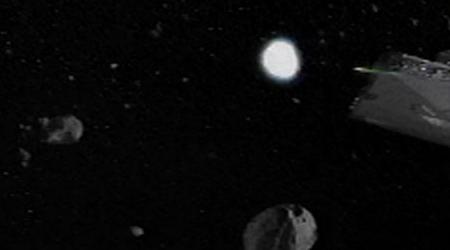
There is no way heat from the bolt traveled to the asteroid at a rate faster than the speed of light. A possibility exists that the bolt was traveling slower than lightspeed. If this is true, TLs cannot be lasers. A possibility also exists that a TL is a multiple-stage weapon, and only one stage is visible to the naked eye. The asteroid's changes before the bolt impact strongly indicate this. The bolt may have been traveling slower than lightspeed, or another stage of the bolt may travel faster than lightspeed. Another possibility is that (considering EGW&T explanation) the laser, used to initiate the reactions that produce the TL bolt, is released toward a target as well. Perhaps this laser is powerful enough to cause this initial heating in the asteroid? In any event, most of the destructive effects of turbolasers are caused by the visible portion of the bolt.
Curtis Saxton, who holds a PhD in astrophysics, states:
Pinning down the nature of beam weapons in SW is a very very tricky proposition. If you take this option I recommend that you confine your discussion to statements of effects and capabilities. Trying to answer the question of "what is a turbolaser" will inevitably lead to a wild goose chase. Frankly, it's easier to make sense of hyperspace.
He also states:
Blaster bolts (and Lightsabre beams, and Superlaser" beams) have too many properties which differ critically from those exhibited by light:It's much easier to demonstrate what TL bolts aren't than to demonstrate what they are or might be.
- Lateral emission, even in vacum
- Bolts sometimes appear to be subluminal, implying that they are just a side-effect, an instability wave of some kind propagating up and down the actual beam
- The destructive beam is not all visible - sometimes the first visible bolt follows after the first destructive effects on the target
- Bolts interact with lightsabre beams (which presumably have similar basic physics) and bolts probably interact with each other; laser rays would pass through each other unaffected
In other words, TL beams are probably based on the same technology as lightsabre beams and "superlaser" beams, but more concrete definitions will be hard to generate.
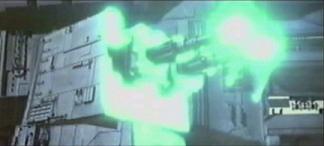
Lightsabre beams cannot be light, as they reach a specific point and stop. Lightsabre beams do not emit much light, as seen in several scenes with dark backgrounds; Luke's lightsabre did not light his path to any degree. Lightsabre beams have also been shown to produce shadows. Refer to Robert Brown's Lightsabre page for more specific information on this subject.
"Superlaser" beams converge together to form a single coherent beam. This is seen every time the Death Star's main weapon fires. Light beams would just pass through each other and continue their previous direction. Also, bright pulses were witnessed traveling down the beams at visually sublight speed. These pulses are not modulations of a light beam, which would travel at exactly lightspeed. These pulses then became part of the final beam itself. Larger pulses are seen in the final beam, probably a combination of the smaller pulses.
It is also interesting to note that blaster rifle bolts seem to be deflected by magnetism. In the A New Hope garbage-chute scene, Luke explains to Han that the chute is "magnetically sealed" after his blaster bolt ricochets several times.
The reason for this deflection is not understood, but it must represent some form of polarisation of the bolt. If this is the case with all blaster or turbolaser beams, then there must be a limit to this deflective capability. This is because all Star Wars starship shields would simply be magnetic-based to deflect TL bolts. In starship combat scenes, we never see this kind of deflection. Perhaps the more powerful weapons are not deflected as easily as blaster rifle bolts?
Of course, the door was magnetically sealed, which prevented it from being "knocked down". Perhaps the bolt ricocheted on the armor, and the magnetic seal has no bearing on the bolt's path.
Blasters have a stun setting as well. This setting renders the target being unconscious for at least several minutes, but leaves no permanent damage. It is unclear what the mechanism that causes this effect might be, and adds more mystery to the workings of the blaster as a whole.
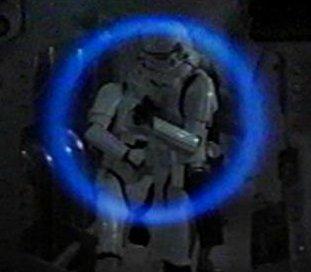
A possibility exists that the stun setting uses sound waves to stun an individual. When the Stromtrooper fired, a high-pitched noise was elicited. The Stormtroopers' audio speakers could filter out this noise, so stun settings would have no effect on them.
Also, this would be a good heat and/or kinetic energy weapon underwater. Physical Therapists sometimes use ultrasound waves to heat bodily tissues that are deep below the surface of the skin (as deep as 5 cm). Sometimes, this treatment is performed in a bucket of water for areas that are hard to maintain good sound head contact (ie, the ankle). Settings of less than 1.5 watts/cm² (sound surface size) are sufficient to produce a visible cavitation in the water; 3 watts/cm² is enough to make a (very small) miniature fountain if the sound head is pointed in a vertical direction.
Weapons with the power of Star Wars blasters could produce sound waves powerful enough to cause concussive and/or thermal damage to an object or individual, if used underwater. Use outside of water (or another similar medium) would yield only stun effects. Of course, use in space would yield no effect to the target, but could seriously damage the firing mechanism.
Robert Brown (who hosts the Lightsabre page) feels that turbolaser bolts are super-heated plasma in a containment field (as described by Wayne Poe because of "flak bursts" at apparently pre-set ranges), and that the stun setting is simply the containment field without the plasma inside. He relates this to a modern "blank" handgun cartidge. However, it seems that the theory of plasma contained in a force field applies more to ion cannons, rather than blasters.
However, visual evidence would seem to support this theory, or some other type of energy field. When Leia was stunned, a bright flash covered her entire body for a very brief period (1 frame of screen time only).
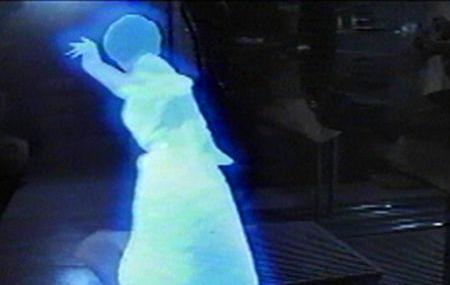
Leia's body was illuminated in a glow similar to that of a TL bolt or a lightsabre blade. Perhaps she was encased in the same energy field that contains such beams? If so, then she did not loose consciousness from a lack of oxygen supply - she was only contained in the energy field for roughly 1/30 second. The cause of her loss of consciousness is not clear. A possibility exists that the field in some way inhibits synaptic activity in the target being. In this case, since the field covers the target's entire body, they would be completely paralysed for at least several moments. Whatever the effects of the stun setting are, they are temporary. Leia was alert and sharp-witted moments later, when she was presented to Vader.
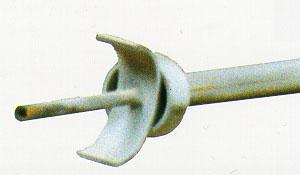
It is interesting to note that the end of blaster and turbolaser barrels have a physical hole. This is witnessed in this barrel from an X-Wing starfighter, as shown above. This implies that some form of matter exits the barrel, as opposed to a light beam, which would exit from a lens or similar device.
The exact nature of Star Wars beam weapons remains open to debate. None of the theories presented above explain all the effects of TL bolts. Only one thing is certain: turbolasers, blasters, and lightsabres are not lasers as we know them today.